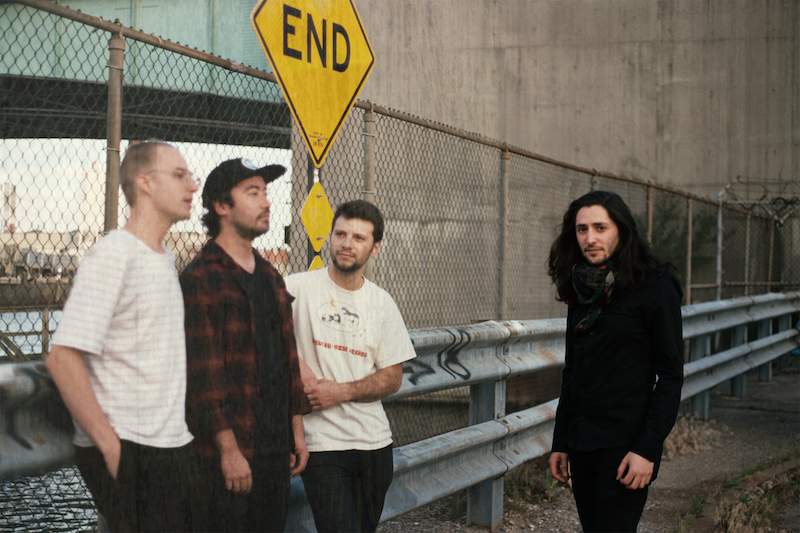- PREMIERE: ZOO – “Own True Love” - October 7, 2021
- PREMIERE: Get nostalgic with ÖZLEM’s 1976-inspired ballad, “Electric Ladyland” - May 20, 2021
- PREMIERE: Personal Space – “Dad USA” - March 11, 2021

Photo Credit: Gaya Feldheim Schorr
For fans of larger, overarching concepts in music, look no further than NYC genre-blenders Underorder. They have a new EP, Other Ways To Be Apart Vol. 1, coming October 4th and, as you could guess by the opening statement and its title, it is the first in the series of three short players fusing together to tell the story of the end and new beginning of two different relationships. Today, we’re bringing you the premiere of Underorder’s latest single, “Selling Rhymes,” along with a companion performance video.
Whereas the previous single, “Heavy As You,” gave us Underorder in their full tilt of acid-jazz-rock , “Selling Rhymes” takes things down a notch as Gabriel Zucker plays more with his background in folk music while building to a wild crescendo. To celebrate the release of “Selling Rhymes,” we sent Zucker some interview questions to get to know him better.
Check it all out below and pre-order Other Ways To Be Apart Vol. 1.
Hi, Underorder! Congrats on your new EP. Can you tell us a little more on who you are and how you first got into making music?
Well, to start at the very beginning: I started playing classical piano when I was five, and then, like I suppose most adolescent boys, picked up the guitar with the aspiration of writing songs when I was 12 or so. My primary practice remains as a pianist, and my work has expanded over time — into jazz and improvisation, and into composition, which I studied in school. But for my whole life I’ve still remained very partial to songs, especially as a listener, and even while I spend much more of my time in the new music and improvised music scenes, I’ve almost always had a project working in a more rock vein.
That’s a quick version of me; this particular project started in earnest about five years ago after the dissolution of a previous band, and I decided to gather collaborators that I knew primarily from the jazz/improvised music scene, who I knew wouldn’t be afraid of complex compositions or noisy arrangements. We’ve had a couple line-up changes since but most of the band is still the same from back then.
What’s your songwriting process like? Who are some of your biggest influences?
At one point my songwriting used to be defined in a sense by a lack of process, and that’s how I kept my songwriting practice distinct from my composition practice: my “classical” work would gestate from a few themes that I would build out over time, but songs were these things that I would just sit down and write when the moment struck. This still happens sometimes when I’m lucky, and there’s a couple tracks on the record that came out this way, but generally now writing my songs feels musically more like my other compositions — starting with some basic ideas, and then really trying to methodically tease out all the possibilities from them. I mean tease them out in terms of rhythm and meter, in terms of harmony, in terms of tonality, in terms of arrangement.
As for the lyrics: I was living in England when I wrote some of the main songs on this record, and there was a period that I didn’t have a bicycle and I had to walk 25 minutes each way to get to the practice room where I played piano, and I got into the habit of improvise-singing lines of my in-progress songs into my phone while I took the walk. By the time I sat down to finalize the words, I often had pages and pages of lyrics transcribed, and I just picked the ones that resonated most. I often got attached to a lot of them, which is why some of these songs ended up on the long side.
Finally, I’d say that post-production is in a sense a significant part of the songwriting process to me. Except for vocals, we tracked this record in just a couple days, the first weekend of October 2017. But those stems are often little more than raw materials. These songs make a lot of sharp moves, entering a lot of specific spaces, and I love using the capabilities of recorded sound to really sculpt those precisely, so that the song is a specific sonic journey. This realization is, to me, a fundamental part of the song.
The influences here span pretty widely, from the post-Steve Coleman jazz world that is the foundation for how I think about meter and rhythm, to the New York improvised music scene that inspired how I think about noise and chaos in the realization of these often-sprawling arrangements. Specifically for this release, though, I think I have to acknowledge the extremely obvious influence of Sufjan Stevens, which you can hear pretty blatantly in a couple of these songs. Later parts of the record don’t show it quite as much but with this batch it’s admittedly quite unmistakable.
How did you approach the overarching atmosphere of the album? It seems just as much a complete thought as it is a collection of individual songs.
Thank you; I take this as a very high compliment! Probably because of my background in classical composition, I spend a lot of time thinking about large-scale form; it seems to me that you’re putting one big work of art out in the world, and you’re leaving an awful lot on the table if it is effective minute-to-minute but doesn’t really cohere into a single journey.
Unlike my classical and jazz work, though, I confess that I sort of reverse-engineered the form onto a bunch of already-written songs rather than vice versa. In this case, when I sat down to figure out what this record might look like way back in early 2017, I found there was this clear theme of distance running through many of the songs I had, distance dealt with in different ways — indignantly, sweetly, simply, angrily — and I got rid of the songs that didn’t quite fit the mold until there was this common thread through them all. I also had a distinction between longer, fully-fledged songs, and shorter, more humble, sketches; the latter, I knew, would be palette-cleansers between chapters built of the longer ones, and I spent a tremendous amount of time trying to sculpt this all into a form that made sense. In fact, I didn’t quite nail it; as late as this spring, there were two extra songs and the macro form of the record was not quite satisfying.
The final product here is sort of a 3×3 form: three acts, each made of three songs, each act mirroring the others in the shape of the three songs, plus an introduction at the beginning and a postlude at the end of the whole record. Each act is like another incarnation of the same path. The so-called “palette-cleansers” are the last song in each act, clearing the way for what comes next.
This release, of course, is just the introduction and act one; volumes 2 and 3 are forthcoming in the next few months. It’s like an old-fashioned serial.
Any new NYC-based artists/venues/purveyors of the arts you could turn our readers onto?
I’d be remiss if I didn’t start by pointing you to the other artists on Floordoor Records, our label for this record. I’ll specifically point you to A Bunch Of Dead People and Wsabi Fox (the latter of which, full disclosure, I sometimes have the honor of playing in). I should also mention Grand Kid, the solo project of underorder’s lead guitar player Dan Kleederman – he’s putting out a debut record in the near future which is truly excellent. And finally, as it’s rather timely, I’ll put in a plug for my friend Grey Mcmurray’s new record Stay Up which came out last week, and is without a doubt simply one of the best albums I’ve ever heard.
Venues: I’ll give a quick self-interested shout-out to Spectrum, a space I help manage and curate, which — in our old location in Manhattan — in fact hosted the very first underorder concert back in November 2014.
Where can we follow you and where can our readers catch you live next?
Since we’re releasing this record in three parts we have the luxury of getting to play (at least…) three release shows. The first one is next Wednesday at C’mon Everybody, with a Floordoor-curated line-up, and the second one is November 19 at St. Vitus, which we put together with our friends in Stimmerman (who I’d also urge everyone to check out). More will be announced soon, including a tour around the northeast – we’ll post it on underorder.com and facebook (facebook.com/underorderband) and instagram (@gabriel.zucker).
Any parting thoughts? Open platform!
I mentioned this already, but this release is just part one of three! We broke the record into parts to make each individual one a little more digestible, but they will build on each other; if you like what you hear now, make sure to check back with us for the second and third releases in November and January. The story continues…
I want to take the opportunity to gush a bit about Dan Kleederman, Marty Kenney, and Connor Parks, the incredibly awesome musicians who are in this band, and have been consistently excited and supportive about this music for such a long time. It’s a rare thing in New York to be able to keep a project together over time and grow with it, and I feel really lucky to be able to do so.
And I want to acknowledge Chris Connors, my fearless partner in crime on this record and all my other studio projects, who has been helping me realize my crazy musical dreams for years and without whom this record would have been entirely impossible.







